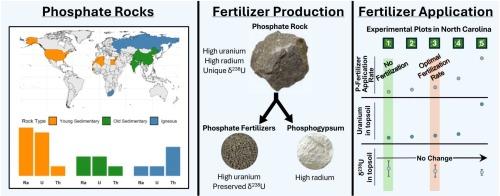全球生产的磷矿、矿物肥料和磷石膏废物的放射性核素和铀同位素指纹及其对环境的潜在影响
IF 11.3
1区 环境科学与生态学
Q1 ENGINEERING, ENVIRONMENTAL
引用次数: 0
摘要
在磷矿(pr)中铀(U)、钍(Th)和镭(Ra)的存在导致这些放射性核素在生产的肥料和磷石膏废物副产品中富集。本文介绍了稀土、化肥和磷石膏中铀和钍系列放射性核素(238U、232Th、226Ra和228Ra)和铀同位素组成(δ238U)的全球数据集。结果表明,不同地质年代、不同磷矿类型(火成岩与沉积岩)的U、Ra含量和δ238U特征存在系统差异。沉积pr处于238U-226Ra的长期平衡,较年轻的岩石(中新世-二叠纪)表现出较高的226Ra活性(高达1837 Bq/kg),而较老的岩石(≤241 Bq/kg)。相对于烃源岩,肥料倾向于集中在238U中,而在226Ra中耗尽,而磷石膏则保留226Ra。通过对P-和npk肥料(即含氮、磷、钾混合的肥料)的调查发现,肥料保留了源磷矿的U同位素特征,其δ238U值在-0.28‰~ -0.15‰之间,在-0.70‰~ -0.34‰之间,与大陆地壳平均值(-0.29‰)不同。北卡罗莱纳州一个农业研究站的实地数据表明,尽管施用磷肥的U和Ra输入率很高,但表层沙质土壤保留的这些放射性核素很少。施肥对土壤δ238U变化不显著,U和Ra水平较低,低于环境安全阈值。这些发现强调了肥料衍生放射性核素污染在邻近或潜在水资源中的可能性,并提供了肥料的δ238U指纹图谱作为识别环境中肥料衍生铀污染的潜在地球化学示踪剂。本文章由计算机程序翻译,如有差异,请以英文原文为准。

Radionuclides and the uranium isotope fingerprint of globally produced phosphate rocks, mineral fertilizers, and phosphogypsum waste and its potential effect on the environment
The occurrence of uranium (U), thorium (Th), and radium (Ra) in phosphate rocks (PRs) leads to enrichment of these radionuclides in produced fertilizers and phosphogypsum waste byproducts. This study presents a global dataset of U- and Th- series radionuclides (238U, 232Th, 226Ra, and 228Ra) and uranium isotope composition (δ238U) in PRs, fertilizers, and phosphogypsum. Results reveal systematic variations in U and Ra content and δ238U signatures based on geological age and phosphate rock type (igneous vs sedimentary). Sedimentary PRs are in 238U-226Ra secular equilibrium, with younger rocks (Miocene-Permian) exhibiting higher 226Ra activities (up to 1837 Bq/kg) than older rocks (≤241 Bq/kg). Fertilizers tend to be concentrated in 238U and depleted in 226Ra relative to source rocks, while phosphogypsum retains 226Ra. In a survey of P- and NPK-fertilizers (i.e., fertilizers that contain a mix of nitrogen, phosphorus, and potassium), we find that fertilizers preserve the U isotope signature of the source phosphate rocks, with δ238U ranging between -0.28‰ and -0.15‰ for young PRs and -0.70‰ and -0.34‰ for older PRs, which are different from the average continental crust (-0.29‰). Field data from an agricultural research station in North Carolina demonstrate that, despite high U and Ra input rates from P-fertilizer application, surface sandy soils retain little of these radionuclides. Fertilization did not significantly alter soil δ238U and the U and Ra levels were low, below environmental safety thresholds. These findings highlight the potential of fertilizer-derived radionuclide contamination in adjacent or underlying water resources and offers the δ238U fingerprints of fertilizers as a potential geochemical tracer for identifying fertilizer-derived U contamination in the environment.
求助全文
通过发布文献求助,成功后即可免费获取论文全文。
去求助
来源期刊

Journal of Hazardous Materials
工程技术-工程:环境
CiteScore
25.40
自引率
5.90%
发文量
3059
审稿时长
58 days
期刊介绍:
The Journal of Hazardous Materials serves as a global platform for promoting cutting-edge research in the field of Environmental Science and Engineering. Our publication features a wide range of articles, including full-length research papers, review articles, and perspectives, with the aim of enhancing our understanding of the dangers and risks associated with various materials concerning public health and the environment. It is important to note that the term "environmental contaminants" refers specifically to substances that pose hazardous effects through contamination, while excluding those that do not have such impacts on the environment or human health. Moreover, we emphasize the distinction between wastes and hazardous materials in order to provide further clarity on the scope of the journal. We have a keen interest in exploring specific compounds and microbial agents that have adverse effects on the environment.
 求助内容:
求助内容: 应助结果提醒方式:
应助结果提醒方式:


